
Cowpeas as a no-till summer cover crop
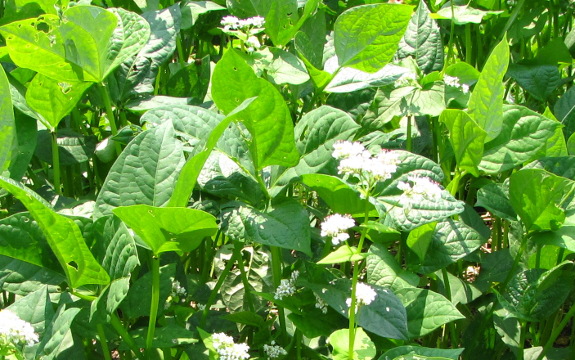
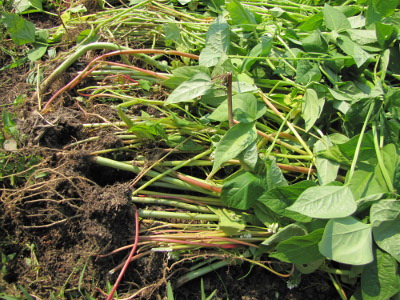 You may remember that I've
been experimenting with mixing
cowpeas in with my buckwheat cover crop this summer. Although
the cowpeas grew well, I'm not sure we'll plant them again next year
for a few different reasons.
You may remember that I've
been experimenting with mixing
cowpeas in with my buckwheat cover crop this summer. Although
the cowpeas grew well, I'm not sure we'll plant them again next year
for a few different reasons.
The obvious strike
against cowpeas is price. Our local feed store doesn't stock
cowpea seeds, and ordering cover crop seeds online is expensive.
Buckwheat seeds bought locally clock in at a bit over a dollar a pound,
but once you factor in shipping, cowpea seeds cost me about $2.40 per
pound even if you buy them in 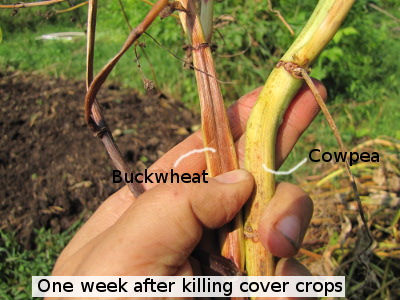 bulk. Now, to be fair,
the one pound of seed I bought (for $4.25 plus shipping) seeded 23 beds
in combination with buckwheat, which means that if I'd planted only
cowpeas in those beds, I would have been spending about 37 cents per
bed. That price tag compares very favorably to the roughly $1.33
per bed I would have spent on straw to mulch the beds down for the six
weeks between crops.
bulk. Now, to be fair,
the one pound of seed I bought (for $4.25 plus shipping) seeded 23 beds
in combination with buckwheat, which means that if I'd planted only
cowpeas in those beds, I would have been spending about 37 cents per
bed. That price tag compares very favorably to the roughly $1.33
per bed I would have spent on straw to mulch the beds down for the six
weeks between crops.
The next problem
is ease of killing. Cowpeas aren't nearly as hard to kill as the overwintering
grains I fought with this spring, but they do tend to
resprout if mow-cut. Even when I pulled up individual plants (a
method that turned out to be faster than mow-cutting), perhaps 10% of
the cowpeas survived to reroot. On the small scale I've been
experimenting with, this regrowth barely had an impact on my gardening
time, but I wouldn't want to have a large area planted in cowpeas.
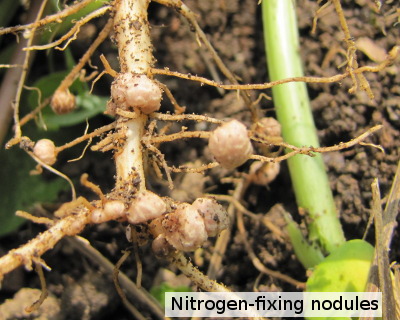 Finally, I was disappointed
by how long the cowpeas took to decompose. I'd read that cowpeas
have a very good C:N ratio of 21, compared to the not-so-shabby C:N of
34 for buckwheat.
Those numbers mean that cowpeas should break down even faster than
buckwheat and be ready to plant into quickly. However, when I
pulled up beds of cowpeas and buckwheat a week before planting and laid
the plants on the soil surface to die, the buckwheat leaves were
completely gone and the stems were halfway decomposed by planting
time. In contrast, the cowpea leaves were still somewhat visible
and the stems were thick and green. Again, since I was
experimenting on a small scale, it was no big deal to layer the cowpea
stems as a mulch around the edges of the garden beds, but on a larger
scale, I'd probably instead have to kill the cowpeas an extra two or
three weeks before planting into them. I guess cowpeas aren't
such a quick summer cover crop after all.
Finally, I was disappointed
by how long the cowpeas took to decompose. I'd read that cowpeas
have a very good C:N ratio of 21, compared to the not-so-shabby C:N of
34 for buckwheat.
Those numbers mean that cowpeas should break down even faster than
buckwheat and be ready to plant into quickly. However, when I
pulled up beds of cowpeas and buckwheat a week before planting and laid
the plants on the soil surface to die, the buckwheat leaves were
completely gone and the stems were halfway decomposed by planting
time. In contrast, the cowpea leaves were still somewhat visible
and the stems were thick and green. Again, since I was
experimenting on a small scale, it was no big deal to layer the cowpea
stems as a mulch around the edges of the garden beds, but on a larger
scale, I'd probably instead have to kill the cowpeas an extra two or
three weeks before planting into them. I guess cowpeas aren't
such a quick summer cover crop after all.
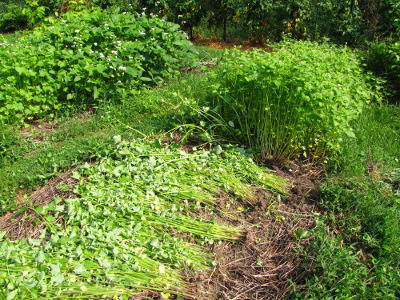 The good news is that I'm
learning to love buckwheat. My gut feeling last year was that
buckwheat didn't do much for the garden beds, but now that I've tried
the cover crop in non-waterlogged, more loamy portions of the garden,
I'm more impressed by this little producer. Filling
garden gaps with buckwheat certainly doesn't hurt the organic
matter content of the soil, and the bees definitely love them.
Next summer, it's going to be buckwheat all the way!
The good news is that I'm
learning to love buckwheat. My gut feeling last year was that
buckwheat didn't do much for the garden beds, but now that I've tried
the cover crop in non-waterlogged, more loamy portions of the garden,
I'm more impressed by this little producer. Filling
garden gaps with buckwheat certainly doesn't hurt the organic
matter content of the soil, and the bees definitely love them.
Next summer, it's going to be buckwheat all the way!
Want more in-depth information? Browse through our books.
Or explore more posts by date or by subject.
About us: Anna Hess and Mark Hamilton spent over a decade living self-sufficiently in the mountains of Virginia before moving north to start over from scratch in the foothills of Ohio. They've experimented with permaculture, no-till gardening, trailersteading, home-based microbusinesses and much more, writing about their adventures in both blogs and books.
Want to be notified when new comments are posted on this page? Click on the RSS button after you add a comment to subscribe to the comment feed, or simply check the box beside "email replies to me" while writing your comment.

I look at it from a different angle. Judging from the pic, the cowpeas are way more valuable for building humus than lightweight buckwheat because of all the cellulose and lignins and such in those tough stems, plus those gorgeous N-fixing nodules. I would pile them into a compost heap at one end of the bed, interspersed with a bit of dirt, and either use the heap in the spring as a grow heap, or spread it over the bed. I would probably try scything it to leave the roots in the ground and deal with the regrowth by hand, but that might be above and beyond the call of duty! Speaking of which, I'd better get going with my winter cover. I appreciate your blog; it can be quite motivating.
Jackie --- I totally agree with your points if we were using the summer cover crops the way we use winter cover crops. We don't tend to have windows long enough for that to make sense in the summer garden, though, so we add the organic matter with the winter cover crops (oats and oilseed radish.) If we were going to leave beds fallow all summer, though, for serious rehabilitation, cowpeas would probably be a good choice.
I've actually found that pulling the plants kills more of them than when Mark cut them right at the ground surface with the weed eater. It doesn't seem to take any longer either, but then, I'm a fast plant-puller.
Good luck with the winter cover!